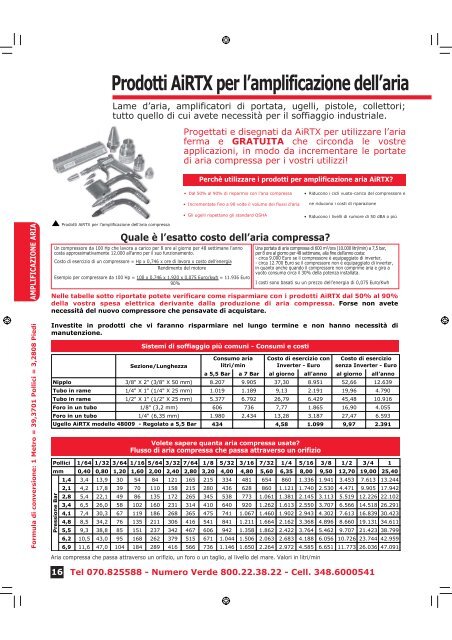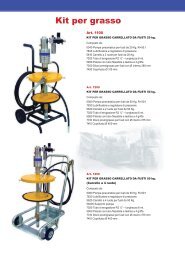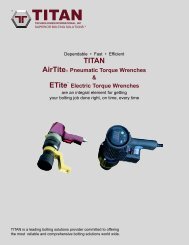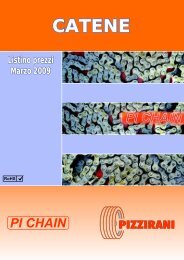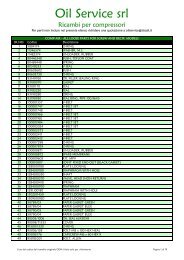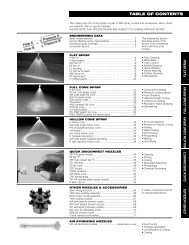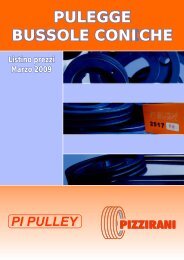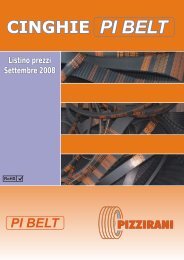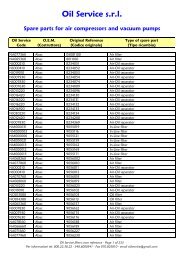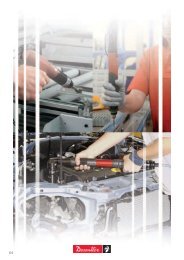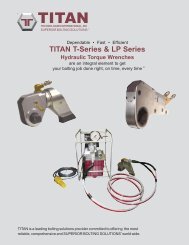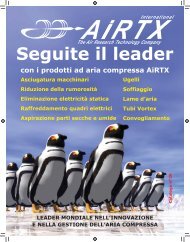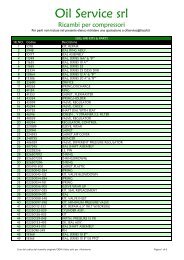Informazioni sui consumi di aria compressa - Oil Service
Informazioni sui consumi di aria compressa - Oil Service
Informazioni sui consumi di aria compressa - Oil Service
Create successful ePaper yourself
Turn your PDF publications into a flip-book with our unique Google optimized e-Paper software.
Prodotti AiRTX per l’amplificazione dell’<strong>aria</strong><br />
Lame d’<strong>aria</strong>, amplificatori <strong>di</strong> portata, ugelli, pistole, collettori;<br />
tutto quello <strong>di</strong> cui avete necessità per il soffiaggio industriale.<br />
Progettati e <strong>di</strong>segnati da AiRTX per utilizzare l’<strong>aria</strong><br />
ferma e GRATUITA che circonda le vostre<br />
applicazioni, in modo da incrementare le portate<br />
<strong>di</strong> <strong>aria</strong> <strong>compressa</strong> per i vostri utilizzi!<br />
Perchè utilizzare i prodotti per amplificazione <strong>aria</strong> AiRTX?<br />
• Dal 50% al 90% <strong>di</strong> risparmio con l’<strong>aria</strong> <strong>compressa</strong><br />
• Incrementate fino a 90 volte il volume dei flussi d’<strong>aria</strong><br />
• Riducono i cicli vuoto-carico del compressore e<br />
ne riducono i costi <strong>di</strong> riparazione<br />
AMPLIFICAZIONE ARIA<br />
Formula <strong>di</strong> conversione: 1 Metro = 39,3701 Pollici = 3,2808 Pie<strong>di</strong><br />
Prodotti AiRTX per l’amplificazione dell’<strong>aria</strong> <strong>compressa</strong><br />
• Gli ugelli rispettano gli standard OSHA<br />
Quale è l’esatto costo dell’<strong>aria</strong> <strong>compressa</strong>?<br />
Un compressore da 100 Hp che lavora a carico per 8 ore al giorno per 48 settimane l’anno<br />
costa approssimativamente 12.000 all’anno per il suo funzionamento.<br />
Costo <strong>di</strong> esercizio <strong>di</strong> un compressore = Hp x 0,746 x ore <strong>di</strong> lavoro x costo dell’energia<br />
Ren<strong>di</strong>mento del motore<br />
Esempio per compressore da 100 Hp = 100 x 0,746 x 1.920 x 0,075 Euro/kwh = 11.936 Euro<br />
90%<br />
• Riducono i livelli <strong>di</strong> rumore <strong>di</strong> 50 dBA o più<br />
Una portata <strong>di</strong> <strong>aria</strong> <strong>compressa</strong> <strong>di</strong> 600 m 3 /ora (10.000 litri/min) a 7,5 bar,<br />
per 8 ore al giorno per 48 settimane, alla fine dell’anno costa:<br />
- circa 9.000 Euro se il compressore è equipaggiato <strong>di</strong> inverter,<br />
- circa 12.700 Euro se il compressore non è equipaggiato <strong>di</strong> inverter,<br />
in quanto anche quando il compressore non comprime <strong>aria</strong> e gira a<br />
vuoto consuma circa il 30% della potenza installata.<br />
I costi sono basati su un prezzo dell’energia <strong>di</strong> 0,075 Euro/Kwh<br />
Nelle tabelle sotto riportate potete verificare come risparmiare con i prodotti AiRTX dal 50% al 90%<br />
della vostra spesa elettrica derivante dalla produzione <strong>di</strong> <strong>aria</strong> <strong>compressa</strong>. Forse non avete<br />
necessità del nuovo compressore che pensavate <strong>di</strong> acquistare.<br />
Investite in prodotti che vi faranno risparmiare nel lungo termine e non hanno necessità <strong>di</strong><br />
manutenzione.<br />
Sistemi <strong>di</strong> soffiaggio più comuni - Consumi e costi<br />
a 5,5 Bar a 7 Bar al giorno all'anno al giorno all'anno<br />
Nipplo 3/8" X 2" (3/8" X 50 mm) 8.207 9.905 37,30 8.951 52,66 12.639<br />
Tubo in rame 1/4" X 1" (1/4" X 25 mm) 1.019 1.189 9,13 2.191 19,96 4.790<br />
Tubo in rame 1/2" X 1" (1/2" X 25 mm) 5.377 6.792 26,79 6.429 45,48 10.916<br />
Foro in un tubo 1/8" (3,2 mm) 606 736 7,77 1.865 16,90 4.055<br />
Foro in un tubo 1/4" (6,35 mm) 1.980 2.434 13,28 3.187 27,47 6.593<br />
Ugello AiRTX modello 48009 - Regolato a 5,5 Bar 434 4,58 1.099 9,97 2.391<br />
Pollici 1/64 1/32 3/64 1/16 5/64 3/32 7/64 1/8 5/32 3/16 7/32 1/4 5/16 3/8 1/2 3/4 1<br />
mm 0,40 0,80 1,20 1,60 2,00 2,40 2,80 3,20 4,00 4,80 5,60 6,35 8,00 9,50 12,70 19,00 25,40<br />
1,4 3,4 13,9 30 54 84 121 165 215 334 481 654 860 1.336 1.941 3.453 7.613 13.244<br />
2,1 4,2 17,8 39 70 110 158 215 280 436 628 860 1.121 1.740 2.530 4.471 9.905 17.942<br />
2,8 5,4 22,1 49 86 135 172 265 345 538 773 1.061 1.381 2.145 3.113 5.519 12.226 22.102<br />
3,4 6,5 26,0 58 102 160 231 314 410 640 920 1.262 1.613 2.550 3.707 6.566 14.518 26.291<br />
4,1 7,4 30,3 67 119 186 268 365 475 741 1.067 1.460 1.902 2.943 4.302 7.613 16.839 30.423<br />
4,8 8,5 34,2 76 135 211 306 416 541 841 1.211 1.664 2.162 3.368 4.896 8.660 19.131 34.611<br />
5,5 9,3 38,8 85 151 237 342 467 606 942 1.358 1.862 2.422 3.764 5.462 9.707 21.423 38.799<br />
6,2 10,5 43,0 95 168 262 379 515 671 1.044 1.506 2.063 2.683 4.188 6.056 10.726 23.744 42.959<br />
6,9 11,6 47,0 104 184 289 416 566 736 1.146 1.650 2.264 2.972 4.585 6.651 11.773 26.036 47.091<br />
Pressione Bar<br />
Sezione/Lunghezza<br />
Consumo <strong>aria</strong><br />
litri/min<br />
Costo <strong>di</strong> esercizio con<br />
Inverter - Euro<br />
Volete sapere quanta <strong>aria</strong> <strong>compressa</strong> usate?<br />
Flusso <strong>di</strong> <strong>aria</strong> <strong>compressa</strong> che passa attraverso un orifizio<br />
Aria <strong>compressa</strong> che passa attraverso un orifizio, un foro o un taglio, al livello del mare. Valori in litri/min<br />
Costo <strong>di</strong> esercizio<br />
senza Inverter - Euro<br />
16<br />
Tel 070.825588 - Numero Verde 800.22.38.22 - Cell. 348.6000541
Prodotti AiRTX per l’amplificazione dell’<strong>aria</strong><br />
Prodotti AiRTX per l’amplificazione della portata <strong>di</strong> <strong>aria</strong> <strong>compressa</strong><br />
per darvi più performance con minore rumore<br />
Standard <strong>di</strong> sicurezza OSHA<br />
- Proteggere gli occhi quando si utilizza <strong>aria</strong> <strong>compressa</strong> per soffiare superfici e rimuovere parti.<br />
- In con<strong>di</strong>zioni <strong>di</strong> sicurezza gli ugelli ad <strong>aria</strong> <strong>compressa</strong> non dovrebbero superare una forza <strong>di</strong> soffiaggio <strong>di</strong> 2 Bar.<br />
- In con<strong>di</strong>zioni <strong>di</strong> sicurezza gli ugelli ad <strong>aria</strong> <strong>compressa</strong> dovrebbero essere costruiti in modo che non vengano<br />
causati danni alla pelle degli operatori; a questo scopo è necessario prevedere nell’impianto tubi <strong>di</strong> sfogo e sfiati<br />
in modo che la forza dell’<strong>aria</strong> <strong>compressa</strong> all’uscita da un ugello o da un tubo abbia una valvola <strong>di</strong> sicurezza che<br />
prevenga il danneggiamento della pelle dell’operatore.<br />
Livello <strong>di</strong> rumore degli amplificatori <strong>di</strong><br />
portata e degli ugelli AiRTX<br />
<strong>Informazioni</strong> generali sul rumore in posti <strong>di</strong> lavoro<br />
Modello Livello <strong>di</strong> rumore dBA Bar Litri/min<br />
30038<br />
48009<br />
15008<br />
15015<br />
85006<br />
85012<br />
38050<br />
76<br />
72<br />
72<br />
76<br />
72<br />
72<br />
74<br />
5,5<br />
5,5<br />
5,5<br />
5,5<br />
5,5<br />
5,5<br />
5,5<br />
424<br />
424<br />
424<br />
560<br />
680<br />
1.360<br />
424<br />
Livello <strong>di</strong> rumore<br />
dBA<br />
110<br />
105<br />
102<br />
92<br />
90<br />
85<br />
60<br />
Applicazione<br />
Tubo aperto <strong>di</strong>ametro 1/2”<br />
Tubo aperto <strong>di</strong>ametro 3/8”<br />
Tubo in rame <strong>di</strong>ametro 1/4”<br />
Tolleranza raccomandata da NIOSH<br />
(Senza protezione dell’u<strong>di</strong>to)<br />
30 minuti<br />
1 ora<br />
90 min<br />
6 ore<br />
8 ore<br />
Obiettivo <strong>di</strong>rumore per la maggior parte delle produzioni industriali<br />
Normale conversazione - Un incremento o un decremento del 10% nel<br />
livello <strong>di</strong> rumore produce una sostanziale <strong>di</strong>fferenza nelle possibilità<br />
che l’u<strong>di</strong>to possa essere danneggiato a causa del rumore<br />
Pressione dell’<strong>aria</strong> <strong>compressa</strong> - Alcune delle cause più comuni <strong>di</strong> bassa pressione<br />
- La richiesta da parte dell’impianto è troppo alta rispetto alla produzione d’<strong>aria</strong><br />
- Per<strong>di</strong>te <strong>di</strong> <strong>aria</strong> <strong>compressa</strong>; le per<strong>di</strong>te standard in uno stabilimento sono circa il 20% dell’<strong>aria</strong> prodotta<br />
- Tubi e connessioni sotto<strong>di</strong>mensionati<br />
- Per<strong>di</strong>te dovute all’attrito all’interno delle tubazioni, curve nei tubi, tubi vecchi e con corrosione interna<br />
Caratteristiche della pressione dell’<strong>aria</strong><br />
con applicazione con tubo in gomma<br />
Caduta <strong>di</strong> pressione per attrito<br />
Tubo in gomma lungo 16,5 metri con pressione ad inizio tubo 7 bar<br />
Portata<br />
litri/min<br />
280<br />
560<br />
850<br />
1.140<br />
1.415<br />
1.700<br />
Consumo<br />
<strong>aria</strong> <strong>compressa</strong><br />
litri/min<br />
0-566<br />
566-1.132<br />
1.132-2.120<br />
2.120-3.400<br />
3.400-4.000<br />
Diametro interno del tubo in gomma<br />
La tabella riporta la caduta <strong>di</strong> pressione (Bar) dovuta ad attrito<br />
alla fine tubo da 16,5 metri, in relazione al <strong>di</strong>ametro del tubo usato<br />
1/4” 3/8” 1/2” 3/4” 1”<br />
0,11<br />
0,62<br />
1,85<br />
3,01<br />
4,20<br />
-<br />
0,05<br />
0,28<br />
0,60<br />
1,21<br />
2,04<br />
3,43<br />
- - -<br />
0,05<br />
0,16<br />
0,33<br />
0,58<br />
0,92<br />
Diametri raccomandati<br />
per i tubi d’<strong>aria</strong> <strong>compressa</strong><br />
0,01<br />
0,03<br />
0,04<br />
0,07<br />
0,10<br />
Diametro minimo del tubo (Pollici)<br />
in relazione alla lunghezza del tubo<br />
0-4 metri 4-17 metri 17-66 metri<br />
5/16<br />
3/8<br />
1/2<br />
3/4<br />
1<br />
3/8<br />
1/2<br />
1/2<br />
3/4<br />
1<br />
1/2<br />
1/2<br />
3/4<br />
1<br />
1 1/4<br />
-<br />
0,01<br />
0,01<br />
0,01<br />
0,03<br />
Caratteristiche della pressione dell’<strong>aria</strong><br />
con applicazione con tubo rigido<br />
Caduta <strong>di</strong> pressione per attrito<br />
Tubo rigido lungo 16,5 metri con pressione ad inizio tubo 7 bar<br />
Portata<br />
litri/min<br />
280<br />
560<br />
850<br />
1.140<br />
1.415<br />
1.700<br />
Diametro interno del tubo rigido<br />
La tabella riporta la caduta <strong>di</strong> pressione (Bar) dovuta ad attrito<br />
alla fine tubo da 16,5 metri, in relazione al <strong>di</strong>ametro del tubo usato<br />
1/4” 3/8” 1/2” 3/4” 1”<br />
0,12<br />
0,65<br />
1,97<br />
3,19<br />
4,44<br />
-<br />
0,03<br />
0,32<br />
0,63<br />
1,29<br />
2,14<br />
3,67<br />
0,02 - -<br />
0,09<br />
0,21<br />
0,35<br />
0,66<br />
1,03<br />
0,01<br />
0,03<br />
0,06<br />
0,09<br />
0,13<br />
-<br />
0,01<br />
0,02<br />
0,02<br />
0,03<br />
AMPLIFICAZIONE ARIA<br />
Formula <strong>di</strong> conversione: 1 bar = 10197 Kgf/m 2 = 14,505 Psi<br />
Fax 070.825810 - posta elettronica oilservice@gmail.com<br />
17


